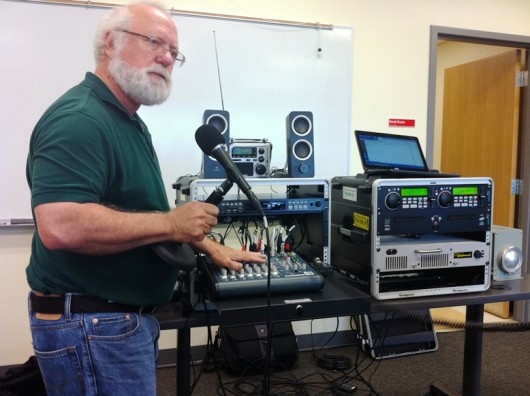
CoastAlaska engineer Rich Parker demonstrates how to do a live broadcast from KRBD’s portable emergency radio system. (KRBD file photo)
Last week, a radio engineer in Juneau loaded four nondescript black cases into a truck and drove it to air cargo. It was one of three emergency radio broadcasting kits of its kind, designed in Southeast Alaska. A few days later, the package arrived in Puerto Rico, where Hurricane Maria wrecked communications infrastructure.
Rich Parker helps keep Southeast Alaska public radio stations on the air, and he’s one of my coworkers. Part of his job as an engineer working on broadcasting infrastructure means maintaining the emergency radio kits – and he prepped Juneau’s for the Puerto Rico Public Broadcasting Corporation.
“We’re here at Alaska Airlines, the air cargo site, to drop off the four containers,” he said.
The emergency broadcasting kit has everything an engineer needs to set up a small radio station in less than half an hour. Sitka and Ketchikan have similar systems.
“Well, this is what’s called a Radio to Go,” he said. “It’s a kit with studio components, uh, mast with an antenna, a small transmitter and mic and other equipment you need to set up an emergency studio.”
The kit has flexible power options. The audio equipment can be powered by a vehicle using an inverter, and the transmitter can even operate at reduced power by wiring together car batteries.
CoastAlaska built the kit. The organization pools business, overhead, and staff among a group of Alaska public radio stations, including KTOO.
“The staff at the Corporation for Public Broadcasting reached out to me knowing we had this equipment,” said Mollie Kabler, executive director of CoastAlaska. “And since it’s a custom built piece of equipment, I didn’t have anywhere to send them to get one, but I said ‘we’ll send it’”
An engineer from public radio station WNYC met the kit in New York and took to WIPR in Puerto Rico. The kit will help the station stay on the air during hurricane recovery.
Reprinted from KTOO.





